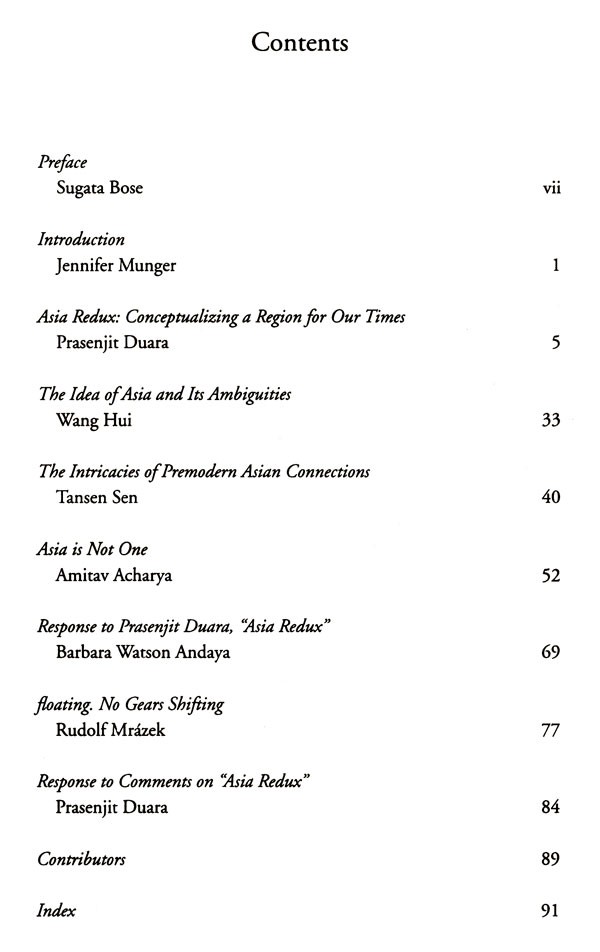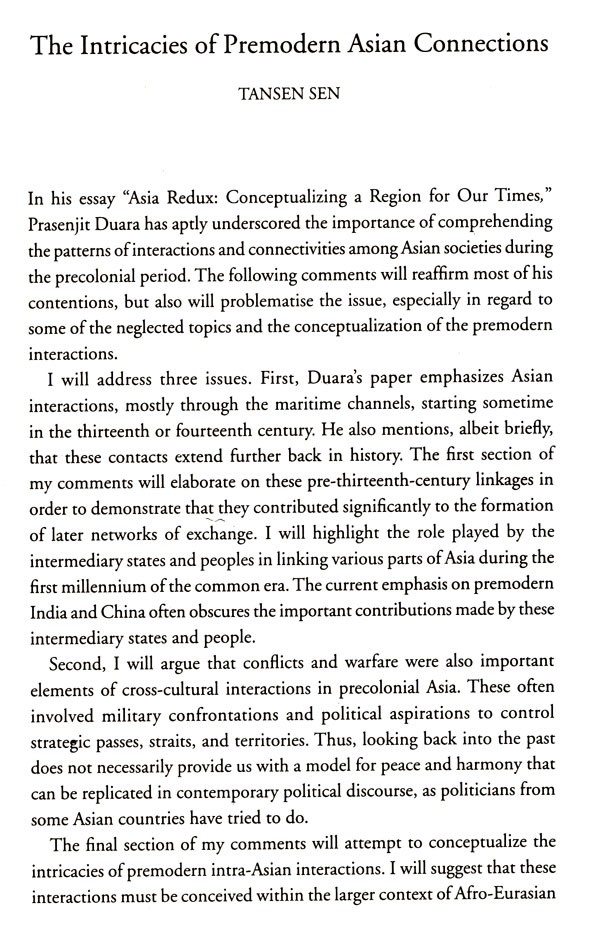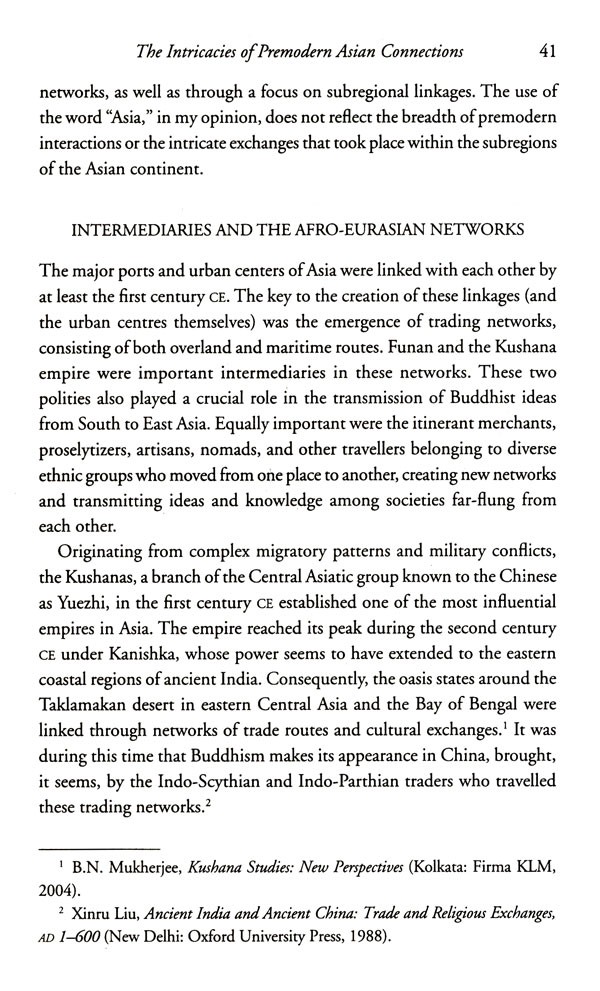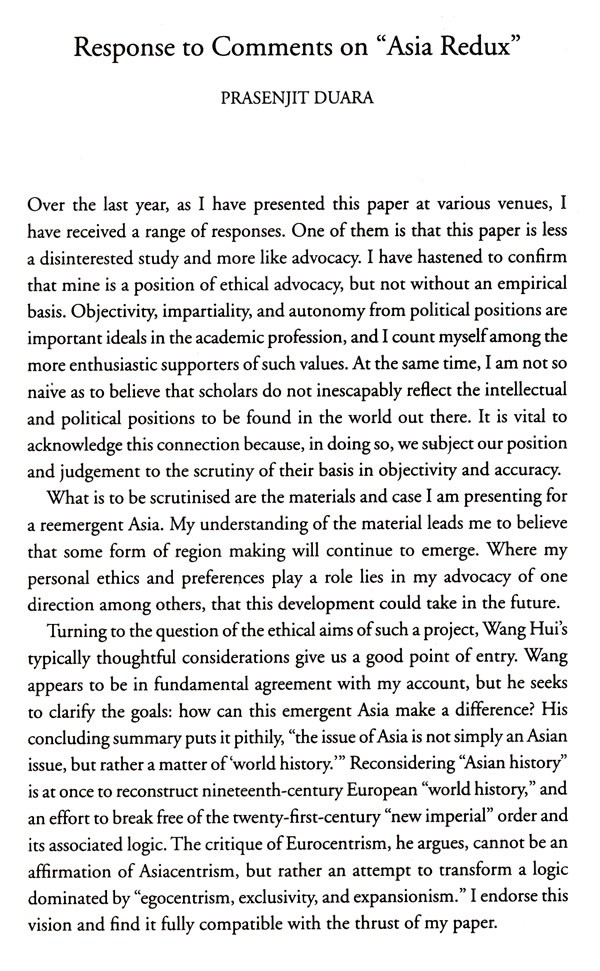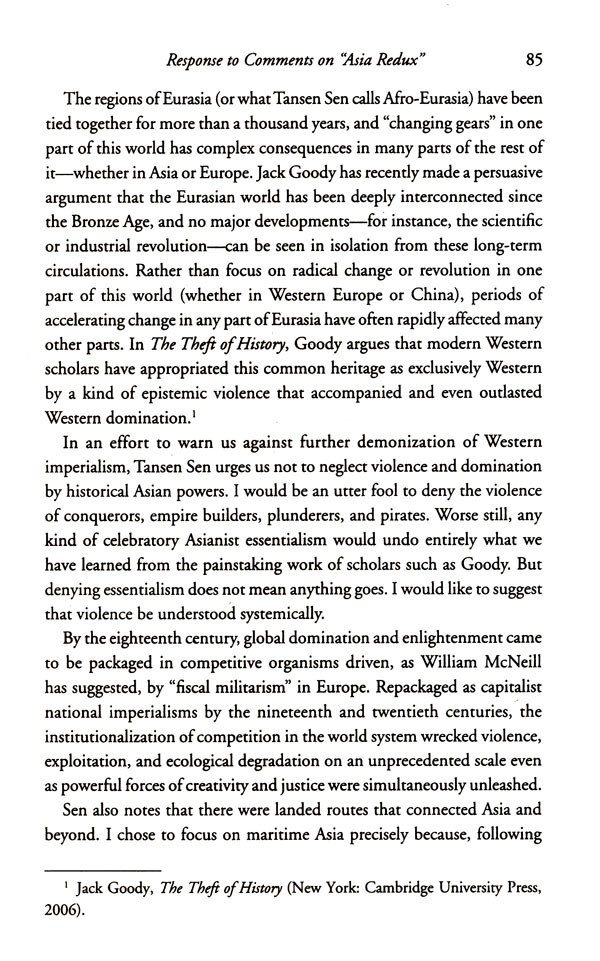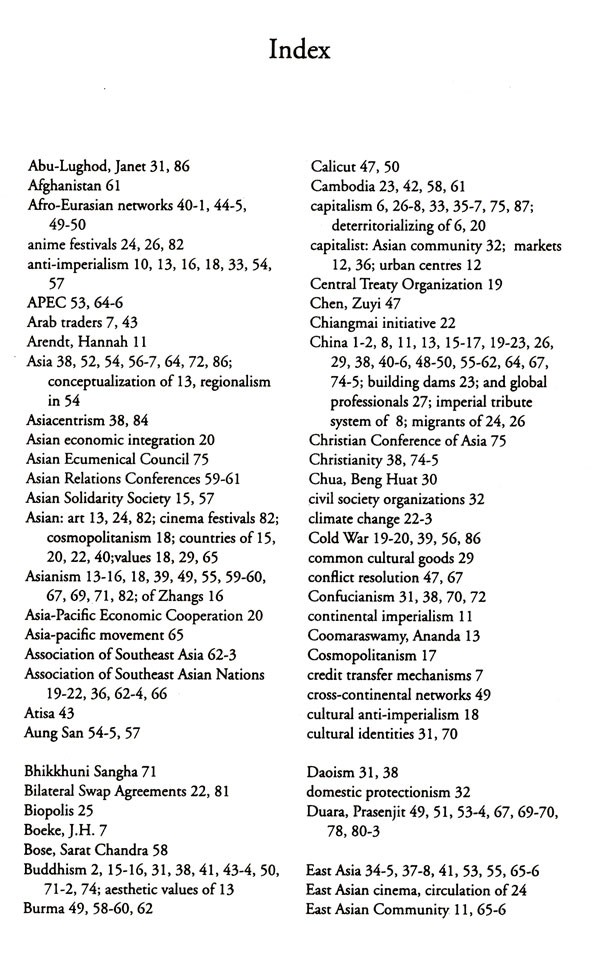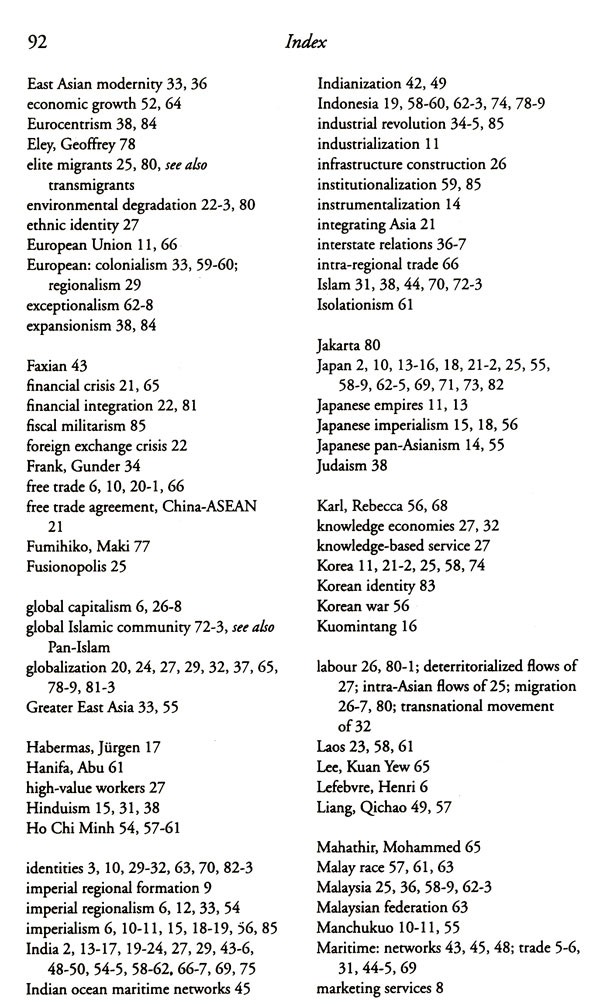
Asia Redux (Conceptualising a Region for Our Times)
Book Specification
| Item Code: | AZA199 |
| Author: | Prasenjit Duara |
| Publisher: | Manohar Publishers and Distributors |
| Language: | English |
| Edition: | 2013 |
| ISBN: | 9789350980217 |
| Pages: | 112 |
| Cover: | HARDCOVER |
| Other Details | 9.8 x 6.15 inches |
| Weight | 386 gm |
Book Description
In the erudite essay that opens this forum, Prasenjit Duara turns to both indigenous thinkers and the premodern past for tools with which to think about Asia in a global age. Contemporary modalities of regional exchange—'weakly bounded, network-oriented, pluralistic, multitemporal'—chime with earlier patterns of cultural circulation without state domination, giving rise to a prophetic vision of "Asia Redux." This attempt to capture the contours of a (re)emergent region was calculated to provoke. And what a debate it kicks off. Wang Hui resolutely reframes imagining Asia as a political project on a world-historical canvas; Tansen Sen greatly complicates the map of intra-Asian commercial exchange in earlier times; Amitav Acharya outlines five competing conceptions of Asia in the domain of international relations alone; Barbara Watson Andaya teases out the paradoxical way in which regional religions make clashing claims about Asian unity; and Rudolf Mrázek asks, what of the Asia that bleeds? what of exploitation and its spawn, the inglorious 'butt-ends' of the global economy? The reward for those who read this collection straight through is a thrillingly cacophonous conversation about how to grasp Asia in our time.
Karen E. Wigen Stanford University
Will a re-emergent Asia extend the violent rivalries and inequalities of western-dominated empires, nations and capital? Or can Asia somehow draw on a relatively more peaceful past of maritime trade, interlinked religions and circulations beyond states to think and make a very different sort of region and world? Prasenjit Duara and his interlocutors define this vital debate on Asia's future through illuminating reflections on its recent and deep past. A touchstone for anyone concerned with the future shape of an inter-connected Asia newly possessed of wealth and power.
Engseng Ho Duke University
Sugata Bose A world-historical transformation is under way in the early twenty-first century as Asia recovers the global position it had lost in the late eighteenth century. Yet the idea of Asia and a spirit of Asian universalism were alive and articulated in a variety of registers during the period of European imperial domination. One of the most creative exponents of an Asiàsense was Rabindranath Tagore (1861-1941) who won the Nobel Prize for Literature in 1913. “Each country of Asia will solve its own historical problems according to its strength, nature and need,” Tagore said during a visit to Iran in 1932, “but the lamp that they will each carry on their path to progress will converge to illuminate the common ray of knowledge... it is only when the light of the spirit glows that the bond of humanity becomes true."
In my book A Hundred Horizons I had claimed that Tagore was an eloquent proponent of a universalist aspiration, albeit a universalism with a difference. This specific claim was part of a larger contention that modern history could be interpreted – not wholly or in full measure, but very substantially – as an interplay of multiple and competing universalisms. The colonized did not simply erect defensive walls around their notions of cultural difference. They were keen to be players in broad arenas of cosmopolitan thought zones and wished to contribute to the shaping of a global future.
The spirit of different universalism that appealed to anti-colonial nationalists in Asia may have been water-borne as it traveled through sea voyages across the Indian Ocean, but was never quite defined by an expanse of water except in a metaphorical sense. It is best in this context not to exaggerate the contradiction between oceans and continents that has crept into some of the scholarly literature. The myth of continents has been subjected to a powerful indictment with some justice as a meta-geographical concept hopelessly tainted by the hubris of European imperialism. The idea of Asia, however, or of Africa, I might venture to add, was not a singular one and had almost as many variations as it had individual authors. More important, Asian universalism as articulated by Asians was certainly at variance with the concrete expression of Asia invented by nineteenth-century European geographers and cartographers. There were strands within Asian thought-worlds that merely inverted and did not undermine the Europe-Asia dichotomy, being content to invest the latter with a higher order of value and virtue. That forms a less interesting dimension of the modern tug-of-war between Europe and Asia. Far more fascinating was the imagination of Asia as an abstract entity transcending the imperial and national frontiers being etched by colonial powers on to the physical and mental maps of the colonized, and thereby serving as a prism to refract the light of universal humanity.
The exchange of views among scholars of Asia triggered by Prasenjit Duara's stimulating think piece “Asia Redux” contains a set of valuable insights into forms of spatial imagination in modern history. Duara's opening salvo has the merit of creatively integrating an analysis of economic networks with an exploration of a cultural ecumene. Dealing with the concepts of region and regionalization with great theoretical finesse, he is able to evoke the history of pre-modern and modern intra-Asian connections in the domain of material life and cultural conceptions of Asia forged in response to European imperialism within a common explanatory framework. Duara's essay is of great topical salience in our contemporary global moment.
Jennifer Munger The papers in this publication began as a discussion between Journal of Asian Studies editor Jeffrey Wasserstrom and author Prasenjit Duara, who wrote a think piece for the journal entitled “Asia Redux: Conceptualizing a Region for Our Times.” Early on, the two agreed that the paper should be published with commentaries, along the lines of the Rule of Law forum spanning India and China in volume 68: 1 (February 2009). The topics of the paper, which include the ways in which the area we call Asia has been interconnected in the nineteenth and twentieth centuries and how it has been conceptualized as a coherent region by Asian intellectuals in the last century, fit in well with the unique aim of the Journal of Asian Studies in cultivating a common ground for discussions that encompass broad issues and regions in Asia. This paper in particular gives scholars the opportunity to problematise conceptions of what constitutes Asia..
As the discussion about how to proceed and who to include in a forum progressed, we at the editorial office found it appealing to expand the idea by hosting a roundtable discussion at the Association for Asian Studies meeting in Philadelphia in the spring of 2010, held as a meeting in conjunction rather than as a formal panel. As Moderator, I asked participants to consider two broad questions: what constitutes Asia, and what attributes or processes serve to allow Asia as a whole, or areas within Asia, to be considered under a single rubric. The working title for the event was “What Makes an Area an Asia,” though over the course of time, and in the conference programme it became “What Makes an Area in Asia.” Either question serves as a useful basis for discussion.
Our goals were to find commentators from a range of disciplines and backgrounds so as to explore and critique the ideas presented in Duara's essay. We sought scholars who had a broad vision and whose work addressed political and/or identity formation in some way. To that end, we invited Kären Wigen, Professor of History and Director of the Center for East Asian Studies at Stanford University, whose work focuses on Japanese studies and geography as reflected in the book she co-wrote with Martin Lewis entitled The Myth of Continents: A Critique of Metageography (1997); Wang Hui, Professor of Chinese Language and Literature at Tsinghua University and former editor of Dushu and the New Leftist; Tansen Sen, historian at Baruch College, CUNY, whose expertise spans China, Japan, India and Buddhism, and author of Buddhism, Diplomacy, and Trade: The Realignment of Sino-Indian Relations, 600-1400 (2003); Rudolf Mrázek, scholar of modern Indonesia and history at the University of Michigan and author of Engineers of Happy Land: Technology and Nationalism in a Colony (2002); and Barbara Watson Andaya, Professor of Asian Studies and Director of the Center for Southeast Asian Studies at the University of Hawaii at Mānoa, President of the Association of Asian Studies in 2005–06 and author of The Flaming Womb: Repositioning Women in Southeast Asian History (2006). We had also invited Howard French, Associate Professor of Journalism at Columbia University, former New York Times Shanghai bureau chief, and the author of A Continent for the Taking: The Tragedy and Hope of Africa (2003) to participate, but in the end, he was unable to attend.
**Contents and Sample Pages**
